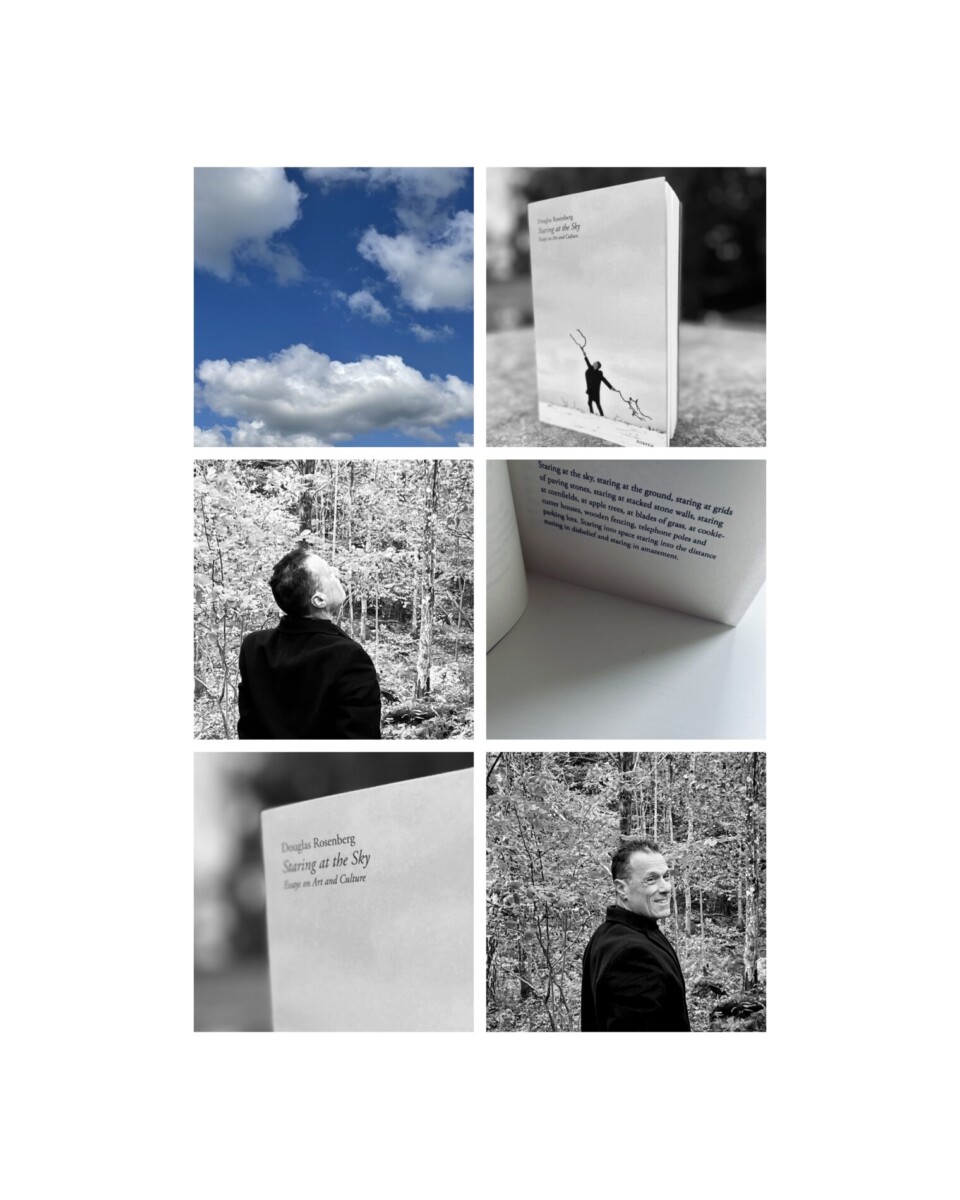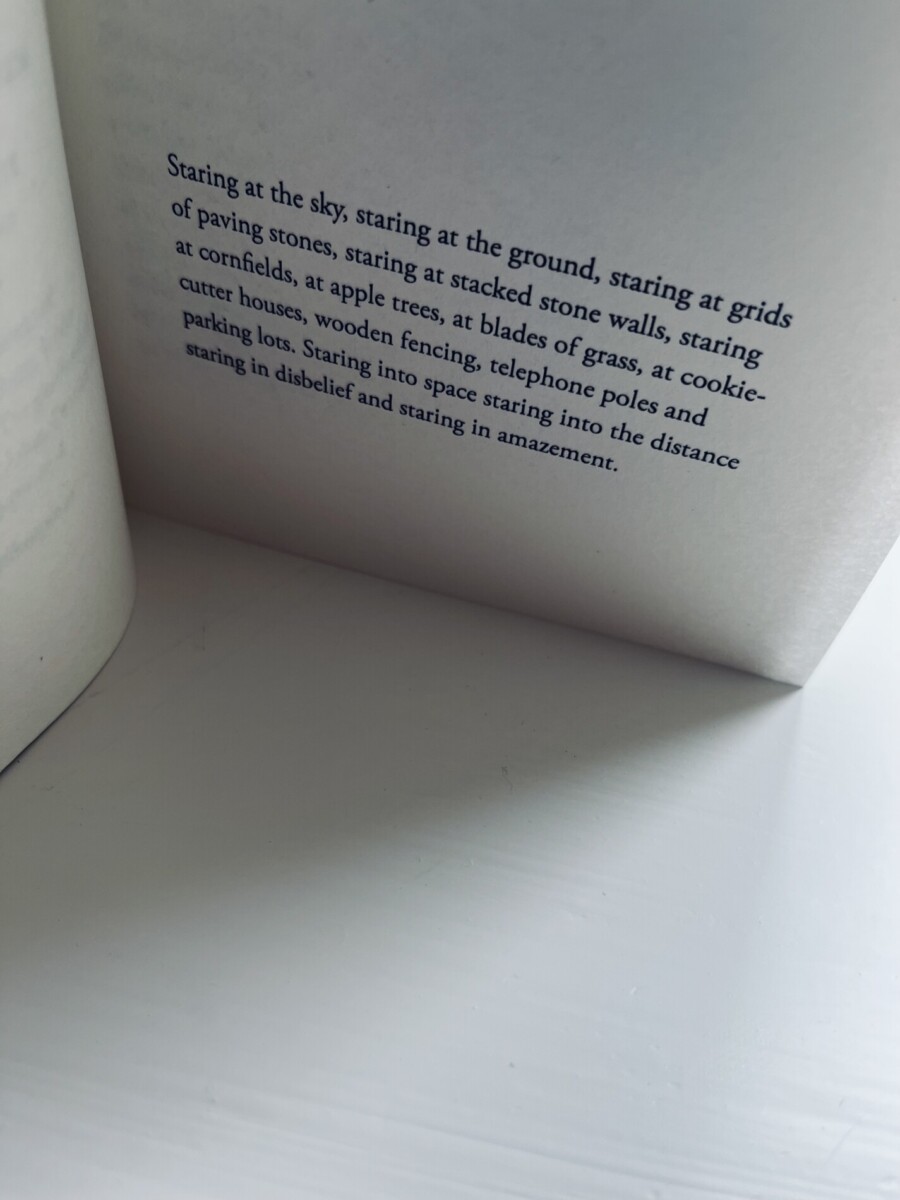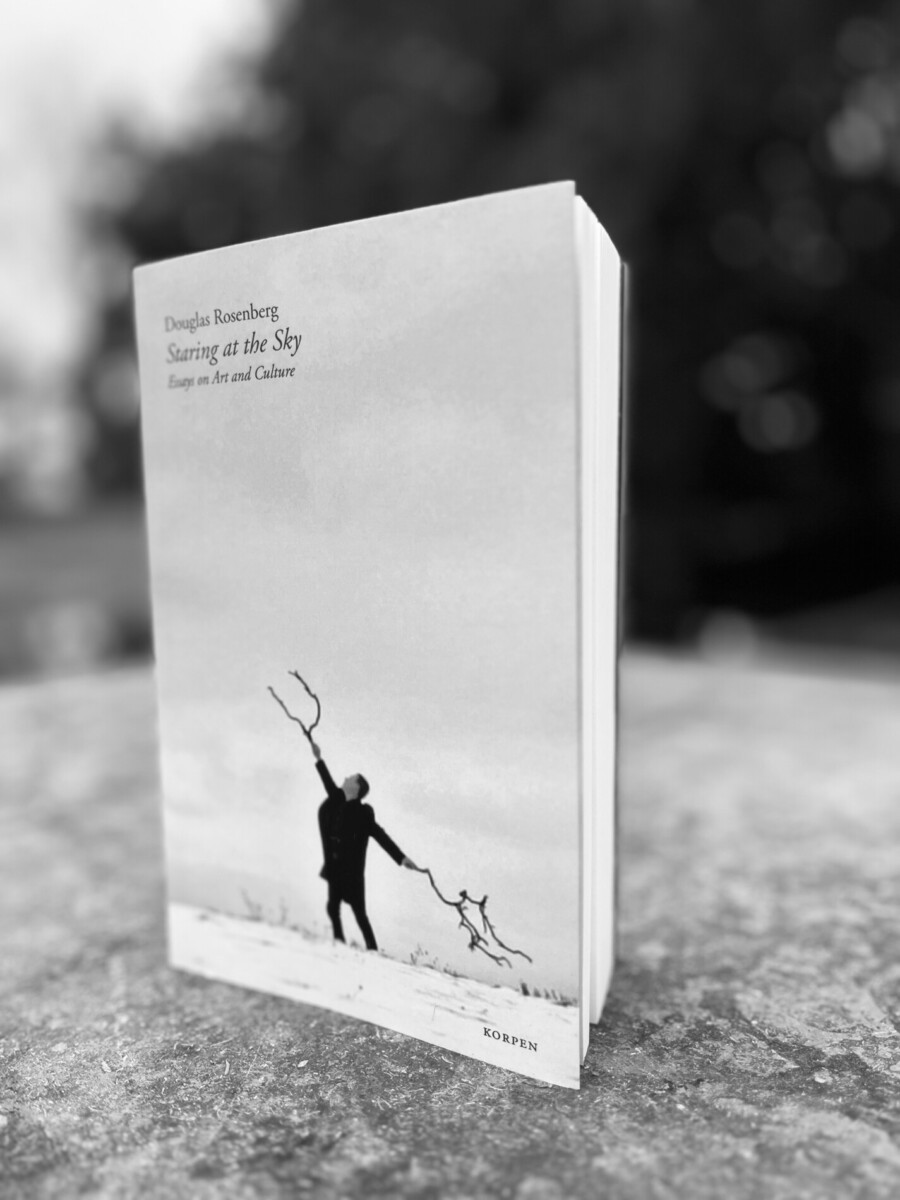There is a myriad of ways to read. Sometimes you love a book, however when finished it will stay on the shelf. Sometimes you only need a couple of chapters: then you leave the temporary companion. And sometimes a book comes into your life to stay. You just know that you cannot “finish it”, you will return and return to it, like to a well. The book becomes a part of your archive, or as my daughter would say, “a go-to place”. That’s when you can consider yourself lucky. And I think many people, much like me, will feel lucky finding Douglas Rosenberg’s new collection of essays; Staring at the Sky (Bokförlaget Korpen, 2024). Whether you are looking to be guided through art history, art theory, searching for new ideas as a teacher, if you want comfort or a new gaze on the well-known (the trees in your backyard may transform into mysteries of hidden knowledge) you will find it.
Rosenberg is most known for his pioneer work within the screendance world, for his films within that genre, likewise for previous literary works like Screendance: Inscribing the Ephemeral Image (Oxford University Press, 2012). With Staring at the Sky he introduces his audience to another of his worlds: one where art, art history, dance, the letter, pedagogy, nature and writing, merges into intellectual meditations that keeps crossing genre-boundaries. To read Staring at the Sky is also to read a fragmented memoir: we get to know what shaped this writer and from that we can put him together ourselves. This fusion is part of what makes me say this is a book to return to, the kind of book that calls you from the shelf.
The structure of the book is quite simple: an essay a week for five years (well, simple might not be the word for such tremendous endurance…). Each essay was originally directed toward the students, staff and alumnae at the Art Department at University of Madison (US) where Rosenbergholds a position as Vilas Distinguished Achievement Professor. The essays, though, were written during the five years he served as chair of the department and came to be as Rosenberg wanted to stay engaged; with students, the arts and the contemporary artworld. Hence, the genre “letter” is close at hand when trying to pin down the nature of these writings. I would like to stop right there and say that the intimate literary form that the letter always suggests is a part of what makes these essays feel so engaging, why they draw you into their worlds. They come with an address, an address that expands throughout the years to also become a much larger crowd (us!) than the firsthand readers. Sometimes they also touch upon being written to the author himself: who am I? Where? Where do I come from and where am I going? Existential questions that the artist constantly re-visits to evolve.
In Staring at the Sky we get to know the artist Douglas Rosenberg through the art that impacted him and shaped him. We get to know his professional being as he shares hisunderstanding of teaching – which I would say is as “a constant dialogue”. And we get to know a broad scenery of art and artists from all over the world. This is not a book, or a writer, that writes the expected history of art. Quite the opposite, there is a feminist approach that runs through the pages, a deep sense of responsibility towards artist outside the western world and a conscience to lift those who before has been in the shadow. This is a proof of change. Rosenberg writes of the art historian, Linda Nochlin, who’s teacher she tells us about, and who once posed that woman had had no impact on the intellectual history of Europe at all…We could possibly thank that teacher too, since he kicked off her writing on the subject. But now I digress from the subject. Or do I? Nochlin is too, of course, present in Staring at the Sky.
“We don’t get to choose what moves us or when we might be moved”. That’s how the essay under the heading “Week 18” begins (note this is year 2016-2017). As stated above, that there are a myriad ways of reading, there is also a myriad of doors and openings into Staring at the Sky: a sentence, a theme, an image, a reflection. However, the statement from week 18 is not only the opening to that essay but also sums up an implicit attitude towards the world and the arts that runs through the book. That attitude is ultimately about being alive, present and receptive. Therefore, also being a questioning creature, someone touched, a human enchanted. All these are transformative experiences that involve listening, touching, seeing – staring at the sky, too. “What if”, writes Rosenberg, “for a moment, we allow ourselves to think about the possibilities of art?/ What if, for today, we think about art as kind of agreement or social contract in which we agree to allow ourselves to be touched, to have our hearts opened to the gracious gift of the creative spirit? What if art was a gift, an offering of hope, of love, and of transcendence?”
Personally, I have found Rosenberg’s vision and conviction that art is all around us, always, changing my outlook on my life, therefore my sense of being in that life. I mean not just my understanding of art, or my art, but also understanding and handling my life, which is somewhat a struggle against the daily hurricane of juggling 3 children, being a poet, artist, editor, writer, teacher in the Arts and – a sensitive human being. With limited resources and options. There is one essay in particular, about a student of Rosenberg’s, that contributed a little more than the others to open my eyes towards the art all around me. This essay is to be found in the section of year 2016-2017 under “Week two”. It starts off with exploring the artist Mierle Laderman Ukeles, but narrows down to portraying an art project called “Artist Working” pursued by Rebecca Kautz. For a year Kautz wore a white pair of overalls with the words “Artist Working” on the back. No matter what activity she was doing, at home or on campus, at the studio or the gallery, the suit was on. She wore it taking care of her children, going to class, her daily life accumulated in that suit, which became an archive of a female artist’s conditions and her practice at the same time. Just like when Rosenberg introduced me to Richard Serra, and I started to feel alive folding the endless laundry (Serra is also in the book) the essay on Kautz made me both more grateful and a tiny bit more… angry? Or should I say,“aware of the state of the world”. I still want her suit. And I still think the choice made by Rosenberg to pose his student next to, and inside a crowd, of historically known icons says that Rosenberg just does not talk the non-hierarchal ideal – he puts it to work in his own book too. That is progressive thought at its best: practiced. 
For those who are inside dance and a bit further from text I still suggest this is a book for you. Reading – get rid of the old prejudice that reading is not a physical practice! A book so full of movements as this one is hard to find and if you ask yourself while reading it where that reading takes place within you, you will find that Staring at the Sky does not just activate your brain (who says reading resides there only anyway?) it will be felt in your hands, feet, eyes, gut, heart also. Ears! Tongue!
Rosenberg presents himself as an artist working in the intersection of performance, media and object-making. I would say his writing happens right at that intersection, where I picture him lying in the grass, staring at the sky.
***
@Photos Karin Brygger and Douglas Rosenberg

